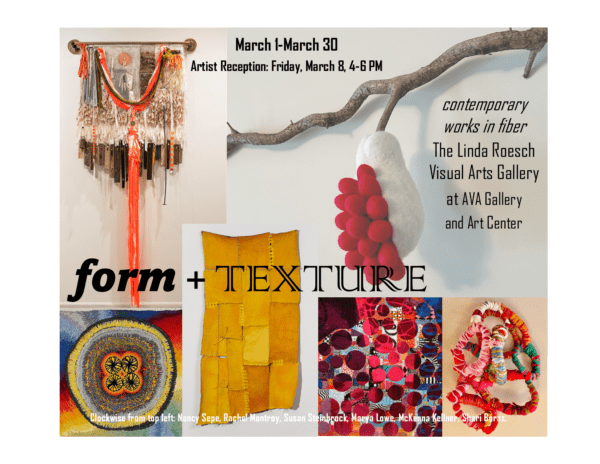
form + texture
Contemporary Works in Fiber
Friday, March 8, 4-6 PM
Celebrating Women’s History Month exhibiting artists include Sarah Ashe, Breslin Bell, Shari Boraz, Rosalind Daniels, Jennifer Davey, Janet Fredericks, Susan Gaffney, Karen Henderson, Eve Jacobs-Carnahan, Mon Kaczyk, Karen Kamenetzky, McKenna Kellner, Marya Lowe, Patricia Miller, Rachel Montroy, Sharon Myers, Leslie Roth, Marcie Scudder, Nancy Sepe, Gaal Shepherd, Gail Smuda, Susan Steinbrock, Fern Strong, Dayna Talbot, and Nancy Thun.
From the intricate tapestries of ancient civilizations to the bold contemporary works of today’s textile and fiber artists, fiber endures as a unique and versatile medium for artistic expression. Its ability to convey emotion, texture, and color while straddling the divide between art and craft makes fiber art an essential part of the artistic landscape.
In the early 1900s, artists who had been trained in the interdisciplinary techniques of art and design at the legendary Bauhaus school, began teaching internationally, helping to introduce a new generation to fiber techniques. Bauhaus graduate Anni Albers, one of the world’s most celebrated textile artists, only enrolled in the Bauhaus’s weaving workshop in 1923, because the courses she had been more interested in– painting and stained glass– were open only to men. “Circumstances held me to threads, and they won me over,” she said in a 1982 panel discussion. Fiber art emerged within the framework of women’s liberation, civil rights, and antiwar activism. From the early 1960s to the late ’70s, fiber art became a movement. Artists — predominantly women — across Europe and the United States began experimenting with thread and fabric, often pushing materials into three-dimensional objects. Contemporary artist Sheila Hicks, a revolutionary in the fiber art genre, has lived and worked in her studio in Paris since 1964. “Today, the curators walking in the door are different,” she says, “they aren’t textile or craft experts— they are contemporary art experts.”
Fabric is linked to the body and integrated into our lives: we wear it, we sleep under it, we are wrapped up in it when we are born, and we are buried in it. By considering the weight of this, a new perspective expands; fabric and textiles are inherently conceptually complex. Fiber art has seeped into the practice of many contemporary artists, blurring the line between artistic disciplines, and incorporating assorted mediums and textural fiber materials. Today the buzzword in contemporary art might be materiality; materiality is a descriptive idea that involves the making, forming, or creating of a thing. In other words, meaning is embedded into the specific materials selected while making an artwork to convey a thought or feeling. Fiber art sits comfortably within the parameters of materiality; sometimes “thread” isn’t just “thread.” It might be a metaphor to represent something larger, like a connection between the artist and the viewer– or a hopeful stitch between two conflicting nations. It might signify a mended wound, and a quilt might imply a blanket used to comfort loneliness. Fiber art can be purely aesthetic as well, distinctively a handmade work of art that is beautifully crafted. The exhibiting artists of form + texture have used brilliant colors, textures, sculpted forms, design, and materiality. Their handmade choices are aesthetically appealing, and poetic titles reveal a rich and personal visual vernacular. The exhibition is a feast for the eyes and heart.
Citations:
Halperin, Julia. “Fiber Art Is Finally Being Taken Seriously.” The New York Times Style Magazine, ARTS AND LETTERS, Sept. 11, 2023.
De Con Cossio, Regina. “The Materiality of Art.” Sybaris, The Provocation.
Image credit: Clockwise from top left: Nancy Sepe, Rachel Montroy, Susan Steinbrock, Marya Lowe, McKenna Kellner, Shari Boraz.



